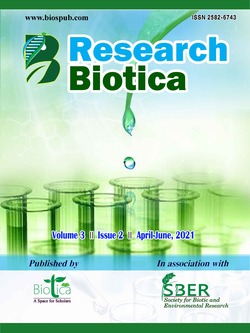
A Review on Agronomic Biofortification for Improving Food and Nutritional Security
Sumit Sow*
Dept. of Agronomy, Bihar Agricultural University, Sabour, Bhagalpur, Bihar (813 210), India
Shivani Ranjan
Dept. of Agronomy, Bihar Agricultural University, Sabour, Bhagalpur, Bihar (813 210), India
DOI: https://doi.org/10.54083/ResBio/3.2.2021.139-144
Keywords: Agronomic biofortification, Foliar fertilization, Malnutrition, Micronutrient deficiencies, Nutritional quality
Abstract
Micronutrients are important not only for better productivity of crops, but also essential for sustaining human and animal health. There is a widespread deficiency of micronutrients especially zinc in the Indian soils. Micronutrient malnutrition is known to affect more than half of the world’s population and considered to be among the most serious global challenges to mankind. Malnutrition is of great public health significance in various developing and underdeveloped countries. Deficiency of iron and zinc can cause various severe health issues. Modern plant breeding has been historically focused towards achieving high agronomic yield rather than nutritional quality, and other efforts related to solve the problem have been mainly through industrial fortification or pharmaceutical supplementation. In humans, problems caused due to micronutrient deficiencies can be solved through biofortification. Biofortification is a promising and sustainable agriculture-based strategy to reduce micronutrient deficiency in dietary food substances. Effective biofortification techniques need to be recognized and applied in an effort to enrich the micronutrient content in the staple crops. Foliar fertilization with micronutrients often increases nutrient uptake and efficient allocation in the edible plant parts than soil fertilization, especially in the case of cereals. Agronomic biofortification can be a way to enrich the food crops leading to decreased micronutrient malnutrition in humans. Moreover, it is the most cost effective and sustainable solution for tackling the micronutrient deficiencies as the intake of micronutrients is on a continuing basis with no additional costs to the consumer in the arid-tropics and sub-tropics of developing countries.
Downloads
not found
Reference
Barua, D., Saikia, M., 2018. Agronomic biofortification in rice varieties through zinc fertilization under aerobic condition. Indian Journal of Agriculture Research 52, 89-92.
Cavender, N.D., Atiyeh, R.M., Michael, K., 2003. Vermicompost stimulates mycorrhizal colonization of roots of Sorghum bicolor at the expense of plant growth. Pedobiologia 47, 85-89.
Chaudhary, D.P., Sapna, Mandhania, S., Kumar, R., 2012. Inter-relationship among nutritional quality parameters of maize (Zea mays) genotypes. Indian Journal of Agricultural Sciences 82(8), 34-37.
Christian, P., Smith, E.R., 2018. Adolescent undernutrition: Global burden, physiology, and nutritional risks. Annals of Nutrition and Metabolism 72, 316-328.
Deshlahare, H., 2019. Biofortification of zinc and iron in chickpea (Cicer arietinum L.) through agronomic intervention. M.Sc. (Ag) Thesis, Indira Gandhi Krishi Vishwavidyalaya, Raipur, India. p. 75.
Douds, D.D., Nagahashi, Pfeffer, P.E., Kayser, W.M., Reider, C., 2005. On farm production and utilization of arbascular mycorrhizal fungus inoculum. Canada Journal of Plant Science 85, 15-21.
Eknath, B.S., 2018. Agronomic biofortification in rabi grain sorghum (Sorghum bicolor L.) under rainfed condition. M.Sc. (Agri.,) Thesis, Mahatma Phule Krishi Vidyapeeth, Rahuri, Maharashtra, India. p. 58.
Gowda, K.M., Halepyati, A.S., Koppalkar, B.G., Rao, S., 2014. Response of pigeonpea (Cajanus cajan L.) to application of micronutrients through soil and foliar spray of macronutrients on yield, economics and protein content. Karnataka Journal of Agriculture Science 27(4), 460-463.
Habib, A.S.M.A., Roy, T.S., Amin, M.R., Haques, M.Z., Rokonuzzaman, M., Sarker, P., 2018. Response of zinc on growth, yield and quality of blackgram (Vigna mungo L.). International Journal of Agronomy and Agricultural Research 13(4), 73-79.
Harris, D., Rashid, A., Miraj, G., Arif, M., Yunas, M., 2008. ‘On-farm’ seed priming with zinc in chickpea and wheat in Pakistan. Plant and Soil 306(1), 3-10.
Imran, M., Rehim, A., 2016. Zinc fertilization approaches for agronomic biofortification and estimated human bioavailability of zinc in maize grain. Archives of Agronomy and Soil Science 63(1), 106-116.
Kamala, M., Karthikeyan, A., 2019. Effect of nutritional fortification of nanoparticles of riboflavin on the growth and development of mulberry silkworm, Bombyx mori L. Research Biotica 1(1), 23-30.
Kumar, A.H., Kubsad, V.S., 2017. Effect of fortification of organics with iron and zinc ongrowth, yield and economics of rabi Sorghum. Journal of Farm Science 30(4), 547-549.
Kumar, R., Mehrotra, N.K., Nautiyal, B.D., Kumar, P., Singh, P.K., 2008. Effect of copper on growth, yield and concentration of Fe, Mn, Zn and Cu in wheat plants (Triticum aestivum L.). Journal of Environmental Biology 30(4), 485-488.
More, S.B., Dabke, D.J., Dodake, S.B., 2015. Effect of different levels of zinc and boon on growth, yield, quality and nutrient uptake by groundnut (Arachis hypogea L.) variety TG-26 under newly terraced laterite soils of Konkan. Indian Society of Coastal Agricultural Research 33(1), 78-82.
Saha, B., Saha, S., Saha, R., Hazra, G.C., Mandal, B., 2015. Influence of Zn, B and S on yield and quality of groundnut (Arachis hypogea L.). Legume Research 38(6), 832-836.
Saleem, I., Javid, S., Bibi, F., Ehsan, S., Niaz, A., Ahmad, Z.A., 2016. Biofortification of maize grain with zinc and iron by using fertilizing approach. Journal of Agriculture and Ecology Research 7(4), 1-6.
Singh, U., Kumar, N., Praharaj, C.S., Singh, S.S., Kumar, L., 2015. Ferti-Fortification: An easy approach for nutritional enrichment of chickpea. The Ecoscan 9(3&4), 731-736.
Verma, C.B., Pyare, R., Aslam, M., Verma, V.K., Singh, V., Sharma, H., 2017. Enhancing growth, yield and quality of lentil through foliar spray of zinc, urea and thiourea under rainfed condition. Agriways 5(2), 123-127.
Wei, Y., Shohag, M.J.I., Yang, X., Yibin, Z., 2012. Effects of foliar iron application on iron concentration in polished rice grain and its bioavailability. Journal of Agricultural and Food Chemistry 10, 1-5.
